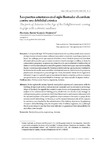Los puertos asturianos en el siglo Ilustrado: el combate contra una debilidad crónica

Use this link to cite
http://hdl.handle.net/2183/27347Collections
- Investigación (FHUM) [116]
Metadata
Show full item recordTitle
Los puertos asturianos en el siglo Ilustrado: el combate contra una debilidad crónicaAlternative Title(s)
The Ports of Asturias in the Age of the Enlightenment: Coming to Grips With a Chronic WeaknessAuthor(s)
Date
2020-12Citation
GARCÍA HURTADO, Manuel-Reyes (2020). "Los puertos asturianos en el siglo Ilustrado: el combate contra una debilidad crónica". Revista de História da Sociedade e da Cultura, vol. 20, 79-102
Abstract
[Resumen] La España del sigloXVIII asiste al renacimiento de su política naval con la creación de importantes infraestructuras militares (arsenales) e inversión tecnológica (navíos de línea). Sin embargo, por lo que respecta al ámbito costero desde la óptica civil, el análisis del estado de los puertos que no tenían un estricto interés estratégico y militar, es decir, los comerciales y pesqueros, se aprecia una situación en la que se alternan la destrucción y el deterioro con las reiteradas peticiones de los gremios de marineros para mejorar los muelles, diques y construcciones anexas. En Asturias podemos afirmar que la práctica totalidad de las demandas de auxilio serán atendidas administrativamente (elaboración de proyectos, planificación de impuestos para sufragar las obras, frecuentes visitas de los ingenieros militares), lo que no equivale a que se ejecutaran de manera completa, perfecta o siquiera que garantizaran una perdurabilidad en el tiempo que fuera más allá de algunos lustros. [Abstract] In the eighteenth century Spanish naval policy experienced a renaissance with the building of important military infrastructures (arsenals) and investment in technology (ships of the line). As regards the country’s coasts from a civil perspective, however, an analysis of its commercial and fishing ports, which were not strictly of any strategic or military interest, paints a picture in which their deterioration and ruination alternated with the repeated requests of the sailors’ guilds for improvements to be made to quays, docks and associated outbuildings. In Asturias, it can be claimed that practically all the requests for assistance were heeded by the administration (the drafting of projects, the planning of taxes to defray building costs, the frequent visits of military engineers, etc.), although this does not mean to say that they were fully met or guaranteed their sustainability for more than a few decades
Keywords
Política naval
Puertos
Ingeniería
Asturias
Naval policy
Ports
Engineering
Puertos
Ingeniería
Asturias
Naval policy
Ports
Engineering
Editor version
Rights
Atribución 4.0 (CC BY 4.0)
ISSN
2183-8615






